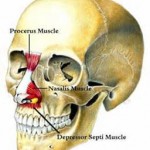In a rhinoplasty there are many manuevers that can effect the final aesthetic result. But the vast majority of these are based on bone and cartilage reduction/addition/modifications. Isolated soft tissue changes in rhinoplasty are far fewer and changes in the muscular attachments are the most infrequently performed. The nasal muscle of interest is the depressor septi nasi muscle which is most frequently perceived as influencing dynamic tip changes. (tip depression with smiling)
In the May 2015 issue of the journal Plastic and Reconstructive Surgery, an article was published entitled ‘Anatomy and Surgical Treatment of the Depressor Septi Nasi Muscle: A Systematic Review’. In this paper a comprehensive literature search was done in which 43 articles were found on this subject. From these articles a total of 175 cadaver specimen studies and over 800 surgical patients who had surgery on the muscle served as the basis from which to draw some consensus on the influence of the effects of depressor septi nasi muscle function and modification.

Dr. Barry Eppley
Indianapolis, Indiana


